Matcha
The Perfect Blend: Matcha And Coffee Together!
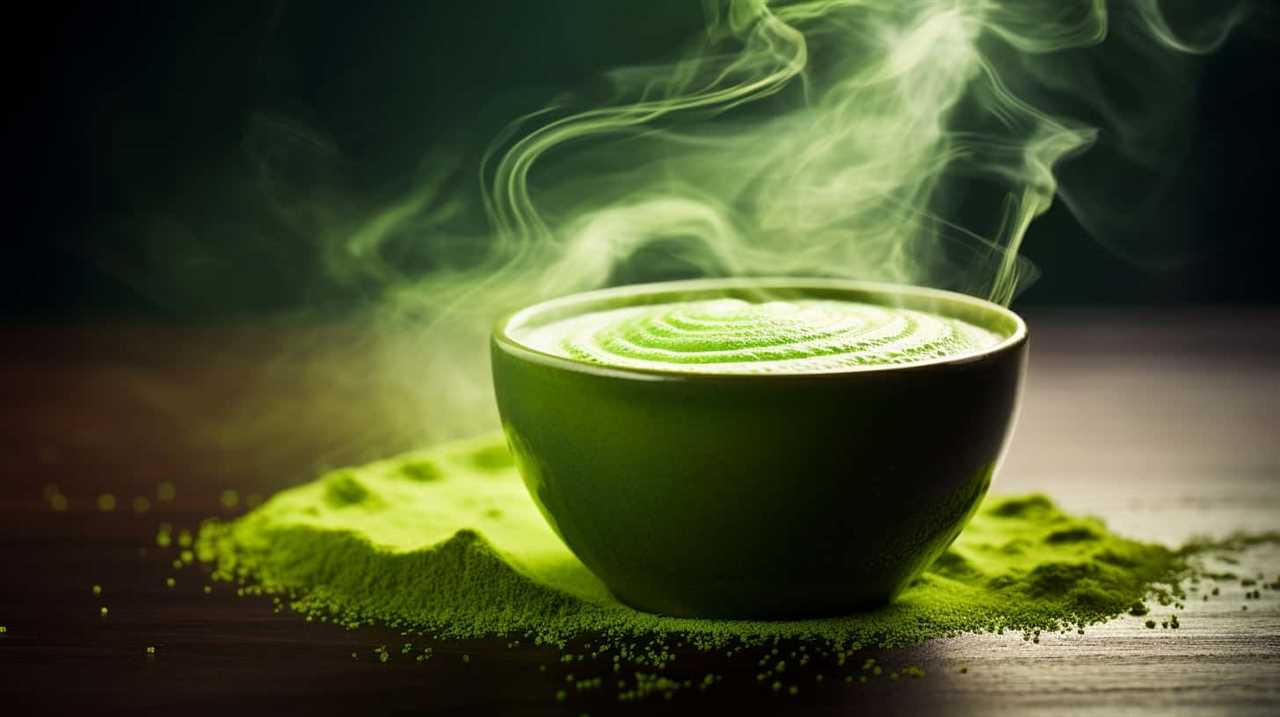
Whoever said that matcha and coffee don’t mix clearly hasn’t experienced the genius combination of these two beloved beverages. Let us embark on a journey of taste and mastery as we explore the wonders of matcha and coffee together.
In this guide, we will delve into the origins of these two drinks, dissect their unique flavor profiles, and uncover the art of brewing them harmoniously. From finding the perfect matcha and coffee ratio to discovering creative recipes, we will unlock the secrets of this fusion.
Not only will we indulge in the deliciousness, but we will also uncover the health benefits that come with this magical union. So grab your cups, my fellow aficionados, and let’s elevate our matcha and coffee game to new heights.
Key Takeaways
- Matcha originated in China and was brought to Japan in the 12th century, while coffee originated in Ethiopia and spread to the Arabian Peninsula in the 15th century.
- Matcha became an integral part of traditional Japanese tea ceremonies, while coffee has become a global phenomenon.
- Matcha has a vibrant, grassy flavor with notes of umami, while coffee offers a rich, bold taste with hints of bitterness and acidity.
- Brewing techniques such as matcha-infused coffee and coffee-flavored matcha latte allow for a fusion of the earthy and grassy notes of matcha with the bold flavors of coffee.
The Origins of Matcha and Coffee
The origins of matcha and coffee trace back to the ancient cultivation and consumption of these caffeinated beverages. Exploring their cultural significance and historical context reveals fascinating insights into the development of these beloved drinks.
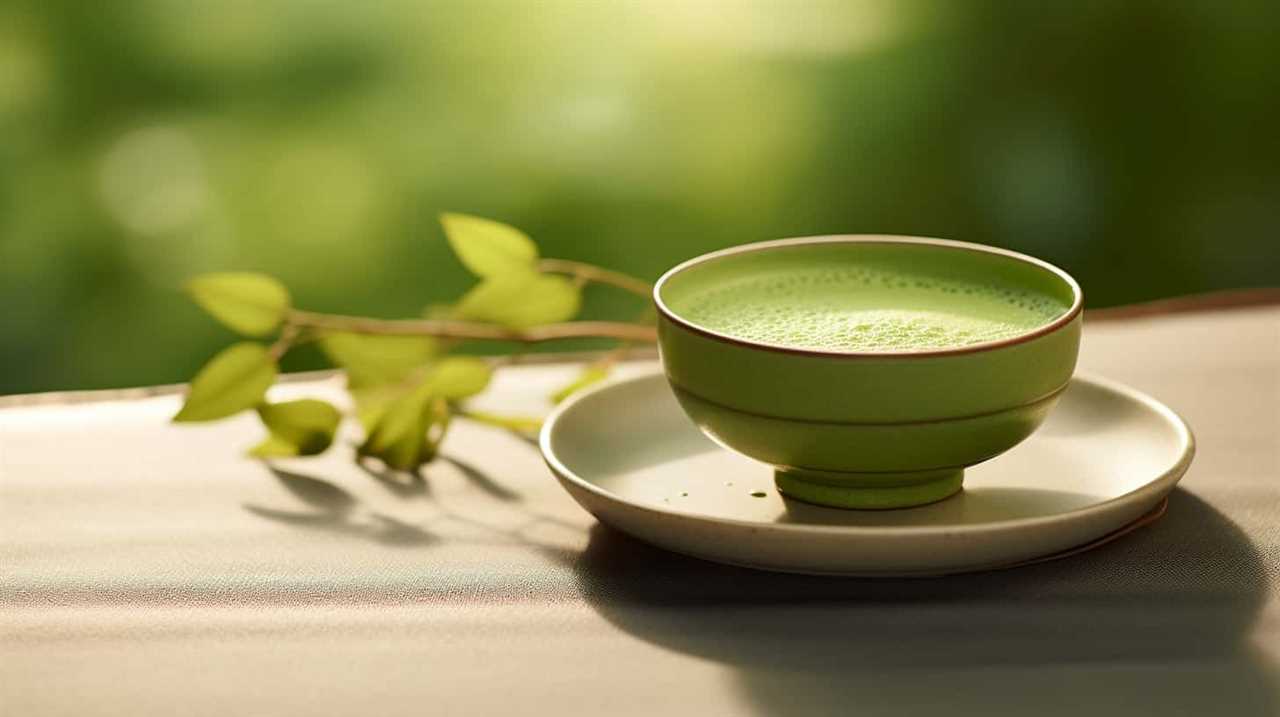
Matcha, a finely ground powdered green tea, has its roots in China during the Tang Dynasty (618-907 CE). It was later brought to Japan by Buddhist monks in the 12th century, where it became an integral part of traditional Japanese tea ceremonies. Today, matcha is celebrated for its vibrant green color, earthy flavor, and numerous health benefits.
Coffee, on the other hand, has a long and storied history that predates matcha. Believed to have originated in Ethiopia, coffee cultivation and consumption spread to the Arabian Peninsula in the 15th century. From there, it made its way to Europe and the Americas, becoming a global phenomenon. Coffee’s rich aroma, bold taste, and energizing effects have made it a staple in cultures across the globe.
Exploring the Flavor Profiles of Matcha and Coffee
When it comes to exploring the flavor profiles of matcha and coffee, we’re in for a treat. These two beverages offer a unique blend of complementary and contrasting taste bud sensations.
Matcha brings a vibrant, grassy flavor with notes of umami, while coffee offers a rich, bold taste with hints of bitterness and acidity.
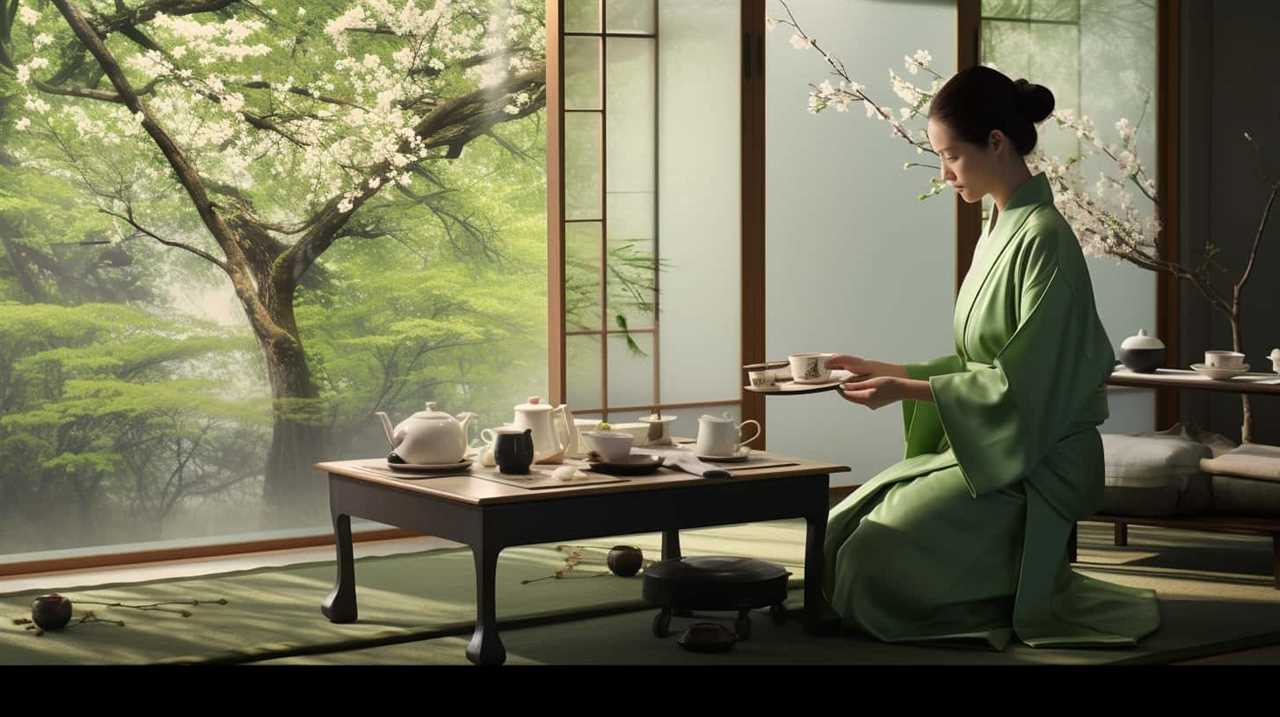
Complementary or Contrasting
As we delve into the flavor profiles of matcha and coffee, we find that these two beloved beverages can either complement or contrast each other depending on personal taste preferences and the specific pairing.
When it comes to complementary flavors, matcha and coffee can create a harmonious combination that brings out the best in both. The earthy, grassy notes of matcha can balance out the bitterness of coffee, resulting in a smooth and well-rounded flavor experience.
On the other hand, for those who enjoy contrasting flavors, the bold and robust taste of coffee can provide a strong contrast to the delicate and nuanced flavors of matcha. This contrasting pairing can create a unique and unexpected taste sensation that appeals to those seeking a more adventurous flavor experience.
Ultimately, whether you prefer complementary or contrasting flavors, the key is to experiment and find the perfect flavor pairing that satisfies your taste buds.
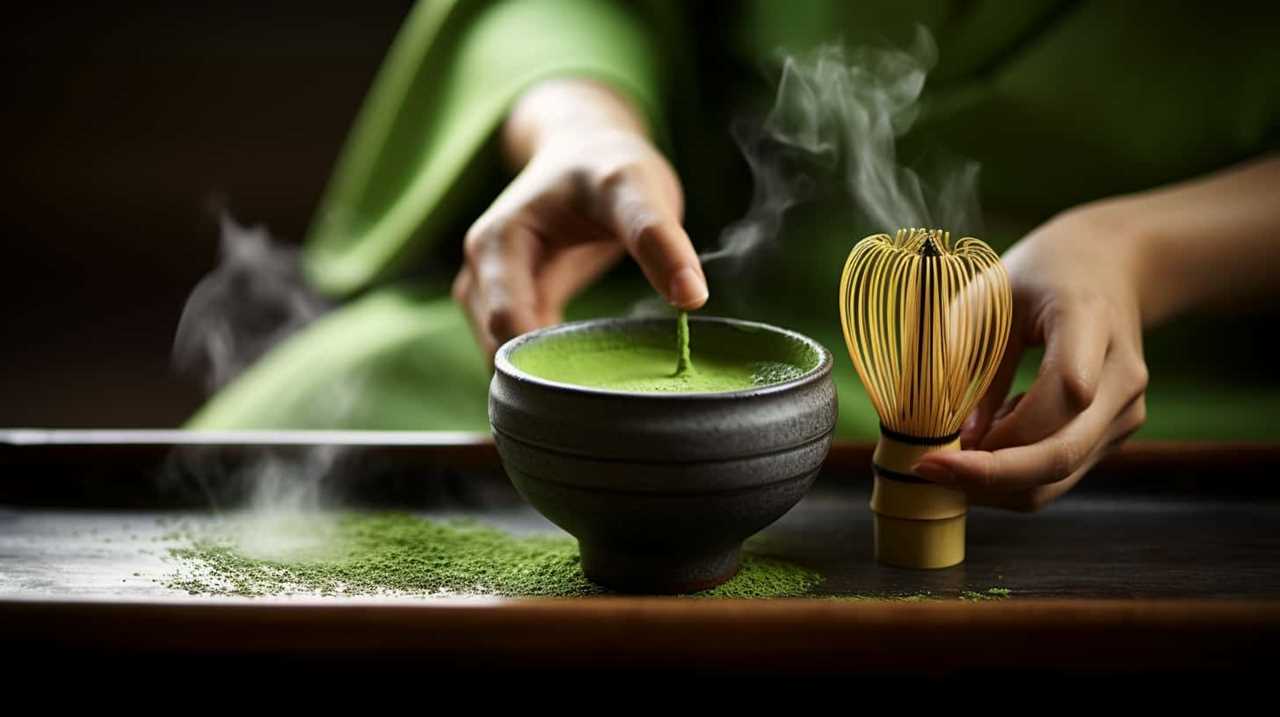
Taste Bud Sensations
Through our exploration of the flavor profiles of matcha and coffee, we discovered the incredible range of taste bud sensations that these two beverages offer when enjoyed together.
The combination of matcha and coffee creates a unique and harmonious blend of flavors that tantalize the taste buds. The rich and earthy notes of matcha perfectly complement the bold and robust flavors of coffee, resulting in a complex and satisfying taste experience.
The combination of these two beverages allows for a truly unique flavor combination that’s both invigorating and comforting. The bitterness of matcha is balanced by the smoothness of coffee, creating a well-rounded and enjoyable drink.
Whether you prefer a hot or cold version, the taste bud exploration that comes with this flavor combination is sure to delight even the most discerning palates.
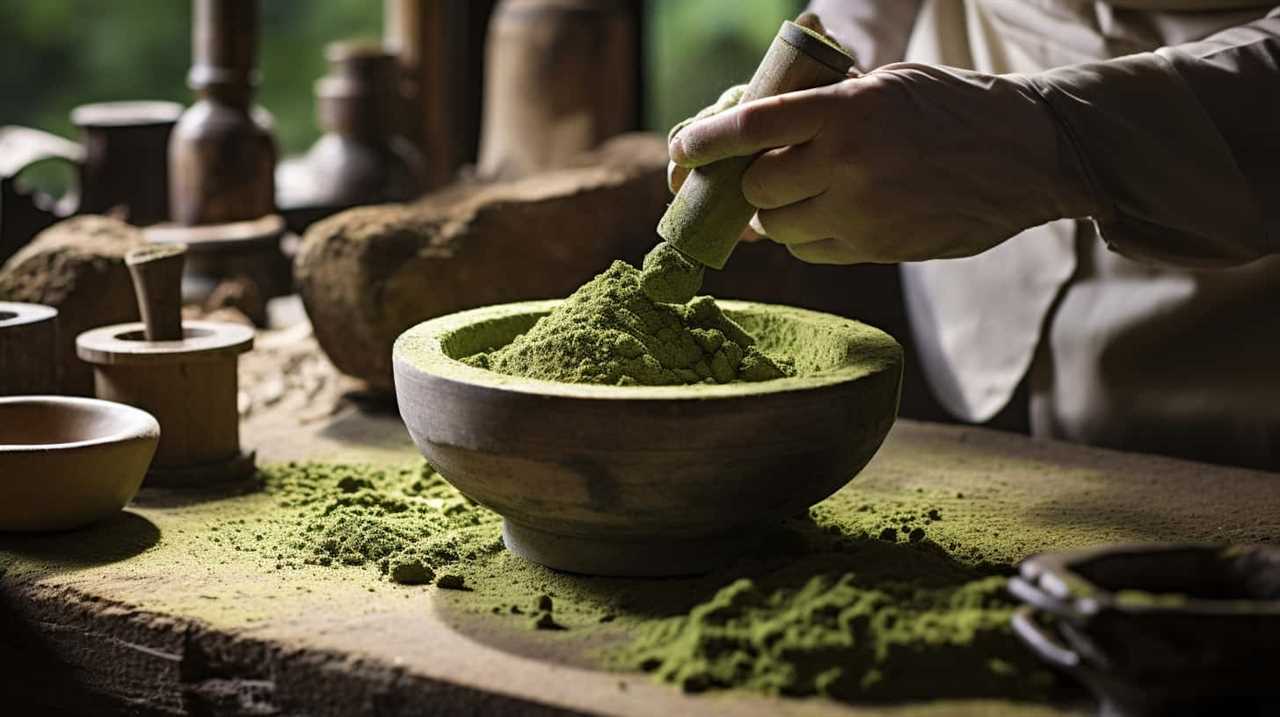
The Art of Brewing Matcha and Coffee Together
Let’s explore the process of brewing matcha and coffee together, combining the flavorful characteristics of both beverages in a harmonious blend. Here are three brewing techniques to create the perfect fusion:
- Matcha-infused coffee:
Start by making a strong cup of coffee using your preferred brewing method. Then, whisk high-quality matcha powder with a small amount of hot water until frothy. Pour the matcha mixture into your coffee, stirring gently to combine. The result is a smooth and earthy blend with a hint of bitterness. - Coffee-flavored matcha latte:
Brew a shot of espresso or a cup of strong coffee. In a separate bowl, whisk matcha powder with a small amount of hot water until smooth. Froth milk of your choice and pour it over the matcha mixture. Finally, add the coffee shot, creating a creamy and rich matcha latte with a coffee kick. - Matcha coffee smoothie:
Brew a cup of coffee and let it cool. In a blender, combine the cooled coffee, matcha powder, a frozen banana, a splash of milk, and a sweetener of your choice. Blend until smooth and creamy, creating a refreshing and energizing smoothie.
With these alternative combinations, you can enjoy the best of both worlds— the earthy and grassy notes of matcha paired with the bold and robust flavors of coffee. Experiment with different ratios and ingredients to find your perfect blend. Get ready to experience a new level of taste mastery!
Blending Techniques: Finding the Perfect Matcha and Coffee Ratio
To achieve the ideal fusion of matcha and coffee, we need to determine the perfect ratio between the two ingredients. Finding the perfect balance is key to creating a harmonious blend that highlights the unique flavors of both matcha and coffee. Experimenting with different ratios allows us to explore the vast possibilities and discover our personal preference.
When it comes to blending matcha and coffee, there are no hard and fast rules. It all depends on individual taste and desired intensity. A common starting point is a 1:1 ratio, where equal parts of matcha and coffee are combined. This creates a balanced flavor profile with hints of both earthy matcha and robust coffee.
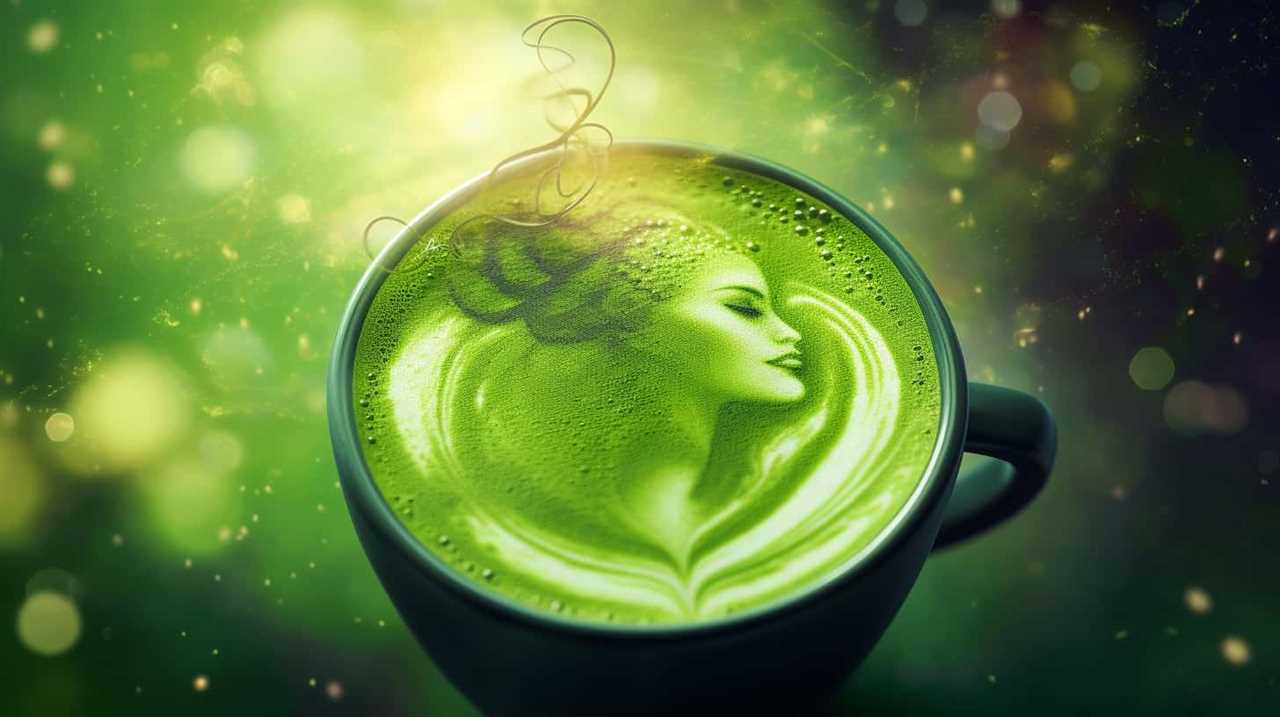
For those who prefer a more pronounced matcha flavor, increasing the matcha ratio to 2:1 or even 3:1 can be an option. This will result in a stronger matcha taste that pairs well with the underlying coffee notes.
On the other hand, if a stronger coffee flavor is desired, reducing the matcha ratio to 1:2 or 1:3 will allow the coffee to take center stage while still incorporating a touch of matcha.
Ultimately, finding the perfect matcha and coffee ratio is a personal journey of experimentation and taste exploration. By trying different ratios and being open to adjustments, we can discover the ideal blend that satisfies our cravings for both matcha and coffee.
Creative Recipes: Delicious Ways to Combine Matcha and Coffee
Now, let’s explore some mouthwatering recipes that combine the unique flavors of matcha and coffee. Get ready to tantalize your taste buds with these creative blends:

- Matcha Latte with a Coffee Twist: Start your day with a creamy and energizing beverage by combining matcha powder, steamed milk, and a shot of espresso. The earthy notes of matcha perfectly complement the boldness of coffee, creating a harmonious balance of flavors.
- Matcha Coffee Smoothie: Blend together matcha powder, cold brew coffee, banana, almond milk, and a touch of honey for a refreshing and nutritious pick-me-up. This smoothie not only provides a caffeine boost but also offers the health benefits of antioxidants from matcha.
- Matcha Coffee Ice Cream: Indulge in a decadent treat by mixing matcha powder into your favorite coffee ice cream recipe. The result is a creamy and velvety dessert with a delightful blend of matcha’s grassy undertones and coffee’s rich aroma.
Now that we’ve explored these delicious recipes, let’s delve into the health benefits of matcha and coffee fusion.
Health Benefits of Matcha and Coffee Fusion
Let’s talk about the health benefits of combining matcha and coffee.
When matcha and coffee are fused together, they create a powerful combination of enhanced antioxidant properties. This means that sipping on a matcha and coffee fusion can help boost our body’s defense against free radicals and promote overall well-being.
Additionally, this unique blend can provide a natural increase in energy levels, helping us stay alert and focused throughout the day.

Enhanced Antioxidant Properties
By combining matcha and coffee, we can unlock the enhanced antioxidant properties of this fusion. The combination of these two powerhouses creates a beverage that not only satisfies our taste buds but also provides numerous health benefits.
Here are three ways in which the fusion of matcha and coffee can boost our wellbeing:
- Increased metabolism: Matcha contains catechins, a type of antioxidant that has been shown to increase metabolism and aid in weight loss. When combined with coffee, which also has metabolism-boosting properties, the effects are amplified, leading to a more efficient calorie burn.
- Potential cancer prevention: Both matcha and coffee are rich in antioxidants, which help to neutralize harmful free radicals in the body. The combination of these antioxidants in the matcha and coffee fusion may have a synergistic effect, potentially reducing the risk of cancer development.
- Improved brain health: Matcha and coffee both contain caffeine, which can enhance cognitive function and improve focus. Additionally, matcha contains L-theanine, an amino acid that promotes a state of calm alertness. Combining these two ingredients can provide a balanced boost of energy and mental clarity.
Increased Energy Levels
The combination of matcha and coffee provides us with increased energy levels and numerous health benefits.
When matcha and coffee are consumed together, the caffeine content in both beverages work synergistically to enhance mental alertness and focus. This is particularly beneficial for those who need an extra boost of energy to start their day or to stay productive throughout the day.
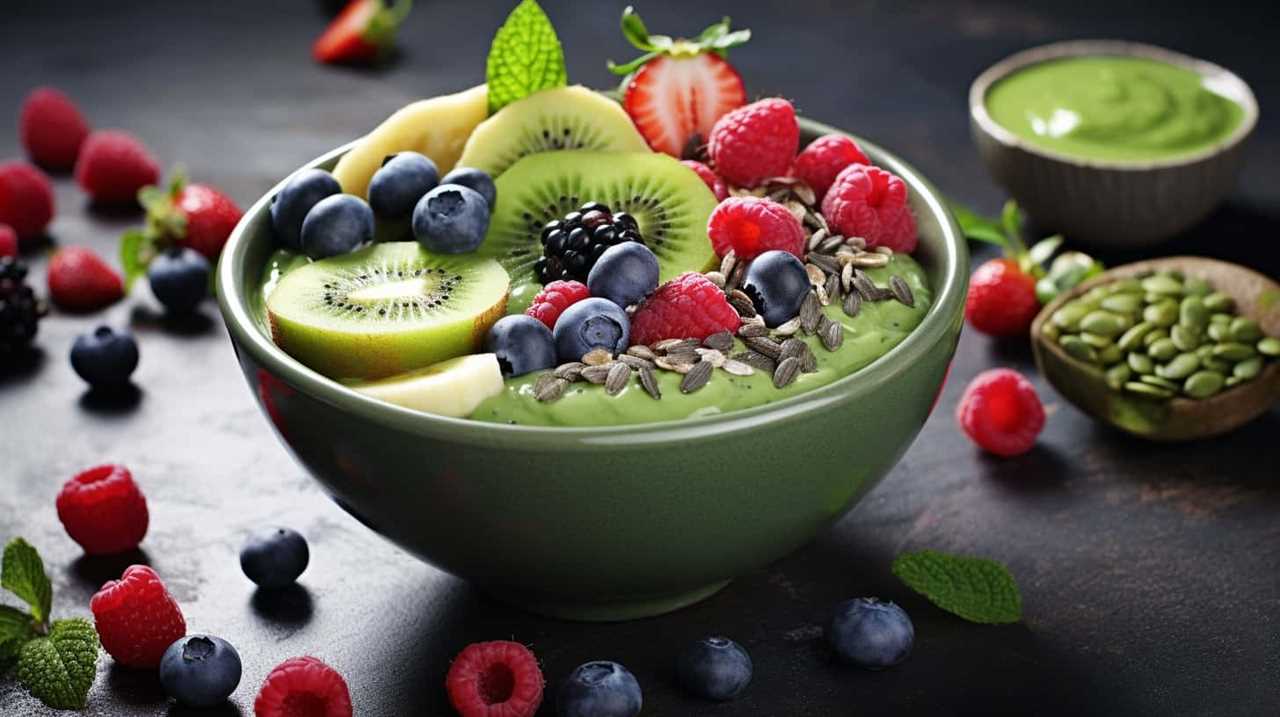
Matcha contains L-theanine, an amino acid that promotes relaxation and mental clarity, which helps to balance out the potential side effects of caffeine, such as jitters or anxiety.
The combination of matcha and coffee not only provides a sustained energy boost but also improves cognitive function and concentration.
Tips for Enjoying Matcha and Coffee Together
To enhance the experience of combining matcha and coffee, we can explore various brewing techniques and experiment with different ratios of the two beverages.
Here are some tips to help you enjoy matcha and coffee together:
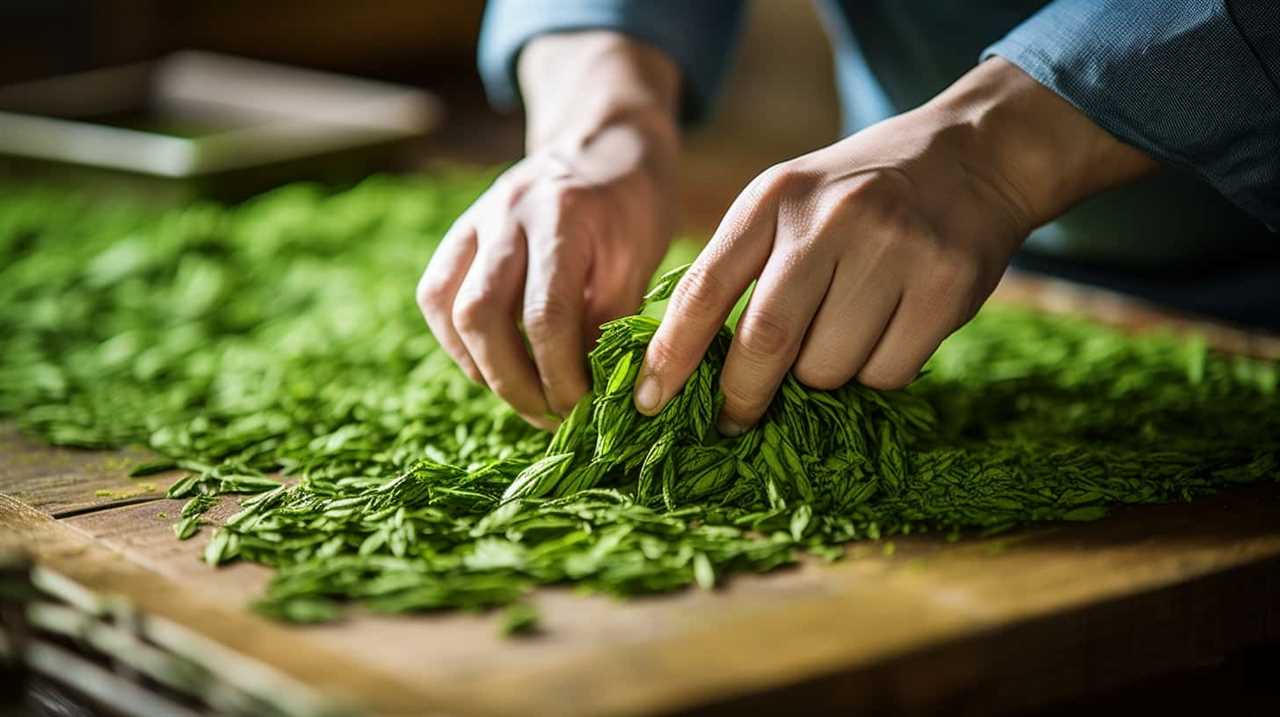
- Flavor combinations: Start by finding a balance between the earthy, grassy notes of matcha and the bold, rich flavors of coffee. You can try adding a small amount of matcha to your coffee to create a subtle hint of green tea flavor, or mix equal parts of matcha and coffee for a more pronounced taste.
- Brewing methods: Experiment with different brewing methods for both matcha and coffee to find the perfect combination. For matcha, you can whisk it in a traditional bowl or use a blender for a frothy texture. When it comes to coffee, try brewing it using a pour-over method or a French press to bring out its unique flavors.
- Ratio experimentation: Play around with the ratios of matcha to coffee to suit your personal taste preferences. Start with a 1:1 ratio and adjust according to your liking. You can also try increasing the amount of matcha for a stronger green tea flavor or vice versa.
Frequently Asked Questions
Can Matcha and Coffee Be Brewed Together in the Same Pot?
Yes, matcha and coffee can be brewed together in the same pot. When combining these two, the brewing methods may vary, but the result is a unique taste profile that blends the earthy richness of matcha with the boldness of coffee.
What Are Some Popular Creative Recipes That Combine Matcha and Coffee?
We’ve discovered some unique matcha and coffee dessert recipes that combine the best of both worlds. Not only do they taste amazing, but the combination also provides an energizing boost to help you power through the day.
Are There Any Potential Health Risks Associated With Consuming Matcha and Coffee Together?
When consuming matcha and coffee together, there are potential health risks to consider. However, by understanding the potential health benefits and how to maximize the antioxidant properties, one can enjoy this unique combination while minimizing any negative effects.
Can I Use Instant Coffee or Does It Have to Be Freshly Brewed for the Fusion?
We can use instant coffee for the matcha and coffee fusion. It doesn’t have to be freshly brewed. Combining matcha and coffee offers a unique flavor and a boost of antioxidants, which can provide various health benefits.
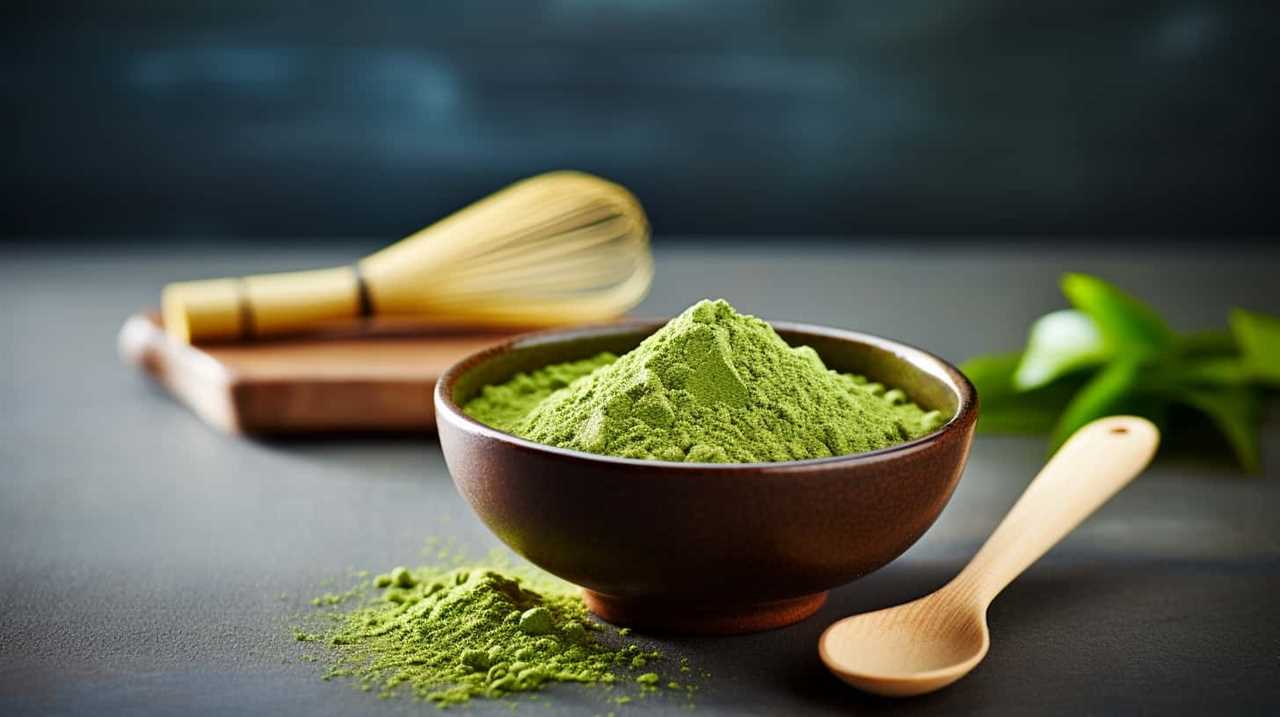
How Do I Find the Perfect Ratio of Matcha to Coffee for a Balanced Flavor?
Finding the perfect ratio of matcha to coffee is a delicious adventure. We explore different methods of blending these flavors, aiming for a balanced taste that satisfies our taste buds and leaves us craving for more.
Conclusion
In the mesmerizing fusion of matcha and coffee, a tantalizing journey awaits your taste buds.
As these two powerful elixirs harmonize, a symphony of flavors dances on your palate, leaving you spellbound.
The carefully crafted balance of rich, earthy matcha and bold, invigorating coffee is a match made in heaven.

Explore the endless possibilities of blending and indulge in creative recipes that will transport you to a realm of pure bliss.
Unleash the full potential of matcha and coffee fusion, and prepare to be amazed.
Justin is a seasoned author, coffee and tea enthusiast, and an essential member of the Cappuccino Oracle team. With a keen appreciation for the complexities of coffee, coffee alternatives, and tea, Justin has dedicated his professional career to exploring these realms and sharing his insights with readers worldwide.
Justin’s immersion in the world of coffee, coffee alternatives, and tea began at a young age, kindling a passion that extended beyond mere consumption. This love for these beverages led him to combine his talent for writing with his devotion to coffee and tea, bringing him to Cappuccino Oracle as a dedicated author.
Matcha
Unveiling The Mysteries Of Matcha: Insights On Its Origins, Production, And Quality

Have you ever been curious about the mysteries behind the rich and natural flavors of matcha? If so, get ready to join me on an adventure as we uncover the secrets of matcha, delving into its origins, production, and quality.
As a lover of all things tea, I have delved deep into the world of matcha, immersing myself in its rich history and intricate production process. From the shade-grown tea leaves to the meticulous grinding technique, every step is a labor of love that culminates in the velvety smooth powder we know as matcha.
Join me as we unravel the secrets behind this ancient Japanese tradition and discover why quality is key when indulging in this verdant elixir. We’ll explore the nuances of flavor, the importance of sourcing, and even delve into the fascinating world of other tea varieties.
So grab a cup, sit back, and let’s dive into the captivating world of matcha.
Key Takeaways
- Matcha tea is made from powdered green tea leaves and has a long and labor-intensive production process.
- Premium matcha is made from the first harvest in early spring, using the top 3 sprouts of the tea plant and ground tencha leaves.
- Cheaper matchas may skip some steps in the production process and are more suitable for matcha lattes.
- High-quality matcha is recommended for sparing consumption, as it has a smoother flavor and more health benefits compared to cheaper matchas.
What is matcha?
I’ve learned that matcha is a powdered green tea made from special tea leaves that are shaded before harvest, and it has a long and labor-intensive production process.
There are different types of matcha available, but the premium matcha is made from the first harvest in early spring, using only the top 3 sprouts of the tea plant. The leaves are then steamed, dried, and have their stems removed before being ground into a fine powder using a specialized mill made of granite.
It’s important to note that high-quality matcha is recommended for sparing consumption, as it has a complex production process that results in a smooth flavor. Matcha also offers various health benefits, such as being rich in antioxidants, boosting metabolism, and improving mental alertness.
Production process
The matcha production process involves shading the tea leaves before harvest and selecting the top three sprouts of the tea plant for premium matcha. Shading is a technique used to enhance the flavor and quality of the tea leaves. By covering the tea plants with shade, the leaves produce more chlorophyll and amino acids, resulting in a vibrant green color and a rich, umami taste.
After the shading period, only the top three sprouts of the tea plant are carefully handpicked for premium matcha. These selected leaves, known as tencha leaves, are then steamed, dried, and have their stems removed.
Finally, the tencha leaves are ground into a fine powder using a specialized granite mill. This process results in the smooth and concentrated matcha powder that we enjoy.
Quality and consumption
Let me tell you, indulging in high-quality matcha is like sipping a vibrant green elixir that awakens your taste buds and nourishes your body with its rich flavor and numerous health benefits. Matcha’s health benefits are truly remarkable. Packed with antioxidants, vitamins, and minerals, matcha is known to boost metabolism, enhance focus and concentration, and strengthen the immune system.
But not all matcha is created equal. Different grades of matcha exist, ranging from ceremonial grade to culinary grade. Ceremonial grade matcha is made from the highest quality tencha leaves and has a smooth, vibrant green color and a delicate, umami flavor. It is best enjoyed on its own, whisked with hot water.
On the other hand, culinary grade matcha is more affordable and is suitable for making matcha lattes, smoothies, and baked goods. Although it may have a slightly bitter taste and a duller color, it still provides health benefits.
So, whether you choose to indulge in high-quality ceremonial grade matcha or opt for the more affordable culinary grade, incorporating matcha into your routine is a delicious way to reap its health benefits.
Frequently Asked Questions
What are some popular ways to enjoy matcha besides drinking it as tea?
Besides drinking matcha as tea, some popular ways to enjoy it include indulging in matcha desserts like matcha ice cream, matcha cake, and matcha cookies. Additionally, matcha smoothies are a refreshing and healthy option.
Are there any specific health benefits associated with consuming matcha?
I’m no expert, but matcha is said to have potential health benefits. Some claim it can aid in weight loss due to its high antioxidant content and metabolism-boosting properties. However, more research is needed to confirm these claims.
How does the quality of matcha affect its flavor and overall experience?
The quality of matcha directly affects its flavor and overall experience. Higher quality matcha, made from carefully selected leaves and processed with precision, offers a smoother and more vibrant flavor, while lower quality matcha may have a less appealing taste and color.
Can matcha be used in cooking or baking?
"Where there’s matcha, there’s a way! Matcha can be used in a variety of cooking and baking recipes, adding a vibrant green color and a unique earthy flavor to dishes like matcha desserts."
Are there any specific tips or techniques for properly preparing matcha tea at home?
To properly prepare matcha tea at home, start by sifting the matcha powder to remove any clumps. Then, choose water at around 175°F to 180°F for the best flavor. Gradually add water to the matcha and whisk in a "W" or "M" motion until frothy. Enjoy!
Conclusion
In conclusion, matcha tea is not just a beverage, but a rich and fascinating tradition that has evolved over centuries.
From its origins in Japan to its intricate production process, matcha is a labor of love.
The quality of matcha is crucial, as the steps taken in its production directly impact its flavor and aroma.
Whether you’re a matcha connoisseur or a beginner, there is a matcha tea out there for you.
So, why not indulge in a cup of this vibrant green elixir and experience the magic of matcha for yourself? It’s a journey worth embarking on!
Arf, an author and an innovative enthusiast of coffee, coffee alternatives, and tea, plays a crucial role as a contributor to the esteemed Cappuccino Oracle platform. Renowned for his curiosity and passion for these captivating beverages, Arf has carved out a unique space for himself in the world of exploration and writing. He realized that coffee, coffee alternatives, and tea are not mere drinks to keep one awake, but universes of flavors and stories waiting to be explored.
Arf’s articles for Cappuccino Oracle blend meticulous research with personal experiences, providing readers with an in-depth understanding of various types of coffee, coffee alternatives, and tea, along with their unique characteristics, cultures, and histories. His honest reviews and engaging narratives guide readers on their own journeys, helping them discover their preferences and find their perfect brew.
Matcha
Unveiling The Truth Behind Starbucks’ Matcha: A Disappointing Blend

Being a lover of tea, I was eager to sample Starbucks’ matcha beverages, anticipating a flavorful and genuine taste. However, to my dismay, I found that it was a subpar mixture of inexpensive green tea powder and an excessive amount of sugar. This was a stark contrast to the customary matcha experience that I had grown accustomed to.
The use of low-quality matcha by Starbucks is driven by the need for mass production and a consistent taste across all locations. But in this pursuit, they have sacrificed the true essence of matcha. Authentic matcha production involves meticulous steps to ensure a high-quality and flavorful product, steps that Starbucks seems to skip.
The result is a matcha latte packed with 32 grams of sugar, equivalent to a can of soda, and a whopping 240 calories. It’s time to unveil the truth behind Starbucks’ matcha and explore better options for a truly satisfying tea experience.
Key Takeaways
- Starbucks uses a cheap green tea powder for their matcha drinks, which may not even be considered matcha.
- The cheap matcha powder is mixed with a lot of sugar, negating the health benefits and undermining the quality of the tea.
- Starbucks’ matcha latte contains a high amount of sugar, similar to a can of soda, and has a significant number of calories.
- To have a better matcha experience, it is recommended to explore premium, first harvest matcha made by talented farmers in Japan and to try different matcha options to find preferred taste.
What is Starbucks Matcha?
Starbucks Matcha is a cheap green tea powder mixed with a high amount of sugar, which not only undermines the health benefits of matcha but also fails to deliver the natural, great-tasting flavor of authentic matcha tea.
The ingredients used in Starbucks matcha include low-quality green tea powder that is likely produced on a large scale. Unlike traditional matcha production methods, Starbucks skips certain steps to save time and money. These steps, such as shading the tea plants to reduce bitterness and selecting the top leaves for their flavor and nutrients, are crucial in creating high-quality matcha.
Instead, Starbucks opts for a blend of cheap green tea powder mixed with sugar, resulting in a dull and bitter flavor. This disappointing blend of ingredients does not live up to the standards of true matcha tea.
Quality vs. Cheap Matcha
Indulging in high-quality matcha is like savoring a delicate melody that dances on your taste buds, while settling for cheap matcha is akin to a discordant symphony that leaves a bitter aftertaste. When it comes to matcha, quality matters. Traditional matcha production is an art that requires time, patience, and attention to detail. The importance of shading the tea plants, selecting the top leaves, and using a stone mill to grind the leaves into a fine powder cannot be overstated. These steps not only enhance the flavor but also preserve the health benefits of matcha. High-quality matcha is rich in antioxidants, boosts metabolism, and promotes a sense of calm. On the other hand, cheap matcha often lacks these qualities as it skips crucial steps and is mixed with sugar and other additives. Don’t settle for a subpar matcha experience; choose high-quality matcha for its exceptional taste and health benefits.
| Traditional Matcha Production |
|---|
| Shading the tea plants |
| Selecting the top leaves |
| Grinding with a stone mill |
The importance of traditional matcha production cannot be overstated. These steps not only enhance the flavor but also preserve the health benefits of matcha. High-quality matcha is rich in antioxidants, boosts metabolism, and promotes a sense of calm. On the other hand, cheap matcha often lacks these qualities as it skips crucial steps and is mixed with sugar and other additives. Don’t settle for a subpar matcha experience; choose high-quality matcha for its exceptional taste and health benefits.
Recommendations for Better Matcha
Exploring different matcha options can lead to a better matcha experience. When it comes to matcha, not all options are created equal. While Starbucks may offer a convenient matcha latte, there are alternative options that provide a more authentic and higher quality experience.
Premium matcha, specifically first harvest matcha, is made by talented farmers in Japan and can be enjoyed plain, without the need for excessive sugar or additives. By choosing premium matcha, you can reap the full benefits that matcha has to offer, such as its high antioxidant content and potential health benefits.
Additionally, exploring different types of matcha, such as Japanese black tea, can expand your taste palate and introduce you to new and exciting flavors. So, why settle for a disappointing blend when there are better matcha options out there waiting to be explored?
Frequently Asked Questions
How is Starbucks matcha different from traditional matcha?
Starbucks matcha differs from traditional matcha in terms of quality and taste. One interesting statistic is that Starbucks’ matcha latte contains 32 grams of sugar, similar to a can of soda, which undermines the health benefits of matcha.
What are the health benefits of matcha and how do they differ between Starbucks matcha and premium matcha?
The health benefits of matcha include high levels of antioxidants, increased energy, and improved focus. However, Starbucks matcha quality is compromised due to the use of cheap powder mixed with sugar, negating these benefits.
Can you customize the sweetness level of Starbucks matcha drinks?
Yes, you can customize the sweetness level of Starbucks matcha drinks. They offer popular matcha drink variations like matcha latte and matcha frappuccino, allowing customers to choose the amount of sweetener they prefer.
Are there any alternative options for matcha drinks at Starbucks?
Yes, there are alternative options for matcha drinks at Starbucks. However, it’s important to note that the taste may not be comparable to traditional matcha. Exploring different matcha options and Japanese black tea can provide a better experience.
What are the steps involved in producing high-quality matcha and how does Starbucks’ matcha production differ?
Starbucks’ matcha production process differs from traditional matcha production in Japan. High-quality matcha involves shading the tea plants, selecting the top leaves, steaming, drying, and grinding them. However, Starbucks skips these steps, resulting in a lower quality and less authentic matcha experience.
Conclusion
In conclusion, after delving into the truth behind Starbucks’ matcha, it’s clear that their blend falls short of expectations. The use of cheap green tea powder mixed with excessive sugar dilutes any potential health benefits and fails to deliver an authentic matcha experience.
To truly enjoy the rich and flavorful taste of matcha, it’s recommended to explore premium, first harvest options crafted by skilled Japanese farmers. Don’t settle for subpar matcha; treat yourself to a tea experience that’ll leave your taste buds dancing with delight.
Arf, an author and an innovative enthusiast of coffee, coffee alternatives, and tea, plays a crucial role as a contributor to the esteemed Cappuccino Oracle platform. Renowned for his curiosity and passion for these captivating beverages, Arf has carved out a unique space for himself in the world of exploration and writing. He realized that coffee, coffee alternatives, and tea are not mere drinks to keep one awake, but universes of flavors and stories waiting to be explored.
Arf’s articles for Cappuccino Oracle blend meticulous research with personal experiences, providing readers with an in-depth understanding of various types of coffee, coffee alternatives, and tea, along with their unique characteristics, cultures, and histories. His honest reviews and engaging narratives guide readers on their own journeys, helping them discover their preferences and find their perfect brew.
Matcha
The Ultimate Guide To Using Chashaku: Your Matcha Essential

Being a lover of matcha, I am aware that the crucial factor in achieving the perfect matcha bowl is the equipment we utilize. When it comes to preparing matcha, there is one tool that is particularly essential: the chashaku.
This bamboo spoon, with its elegant design and precise measurements, is the secret weapon of matcha lovers worldwide. In this ultimate guide, I will take you on a journey through the history and evolution of the chashaku, and show you how to use it like a pro.
From its origins as a metal or ivory scoop to its modern-day incarnation in bamboo, the chashaku has come a long way. With its 48° bend and 18mm length, it effortlessly scoops the perfect amount of matcha from its container.
So grab your chashaku and get ready to elevate your matcha game to new heights. Let’s dive in and discover the wonders of this matcha essential.
Key Takeaways
- Chashaku is a bamboo spoon used to scoop matcha powder in the Japanese tea ceremony and by matcha lovers worldwide.
- Chashaku is one of the three important tea utensils used in the tea ceremony and is about 18mm in length with a 48° bend at the end for scooping.
- Chashaku is made of bamboo to avoid negative reactions with matcha powder and is a great measurement tool for matcha powder.
- Two scoops of chashaku is the standard amount for a bowl of matcha tea, and it is easy to maneuver in matcha tins or natsume due to its small size.
What is Chashaku?
Chashaku is a bamboo spoon used to scoop matcha powder, and it’s one of the three important tea utensils used in the Japanese tea ceremony.
Made from a single piece of bamboo, this elegant tool has a long history dating back to the Muromachi period in Japan. Originally crafted from metal or ivory, chashaku evolved to be made of bamboo due to its natural properties and to avoid any negative reactions with matcha powder.
The design of chashaku is both functional and beautiful, with a length of about 18mm and a 48° bend at the end for easy scooping. There are different styles of chashaku scoops, each with its own unique shape and characteristics. The back of the chashaku has a rough texture, while the face is smooth and sleek.
Whether you’re a matcha lover or a tea ceremony enthusiast, using a chashaku adds a touch of authenticity and tradition to your matcha preparation.
History and Evolution
During the Muromachi period in Japan, the chashaku spoon evolved from being made of metal or ivory to its current bamboo form, which is about 18mm in length and has a 48° bend at the end for easier scooping. The history and evolution of the chashaku is a testament to its significance in Japanese tea ceremonies and its cultural importance in matcha preparation.
| The significance of chashaku in Japanese tea ceremonies | The cultural importance of chashaku in matcha preparation |
|---|---|
| Chashaku is one of the three important tea utensils used in the tea ceremony. | Chashaku is a great measurement tool for matcha powder. |
| Chashaku originated in Japan during the Muromachi period. | Chashaku’s small size allows for easy maneuvering in matcha tins or natsume. |
| Originally made of metal or ivory, chashaku evolved to be made of bamboo. | Chashaku is made from a single piece of bamboo and shaped with a bend for the scoop. |
| Chashaku is made of bamboo to avoid negative reactions with matcha powder. | The back of chashaku has a rough texture, while the face is smooth and sleek. |
The chashaku’s role in Japanese tea ceremonies cannot be understated. It is one of the three essential utensils used in the tea ceremony, alongside the chawan (tea bowl) and chasen (tea whisk). The chashaku’s small size and precise measurement make it the perfect tool for scooping matcha powder. Its evolution from metal or ivory to bamboo shows the cultural importance placed on this utensil. The chashaku’s design, with its gentle bend and smooth face, allows for easy and graceful scooping of matcha. Using the chashaku is not only practical but also a way to honor the centuries-old tradition of matcha preparation.
How to Use Chashaku
To use the chashaku, I simply hold it like a pencil and dip the scoop into the matcha container. Then, I carefully lift the chashaku scoop out and place it over the matcha bowl to dump the powder.
It’s a simple and elegant technique that ensures the perfect amount of matcha every time.
But did you know that there are alternative ways to use the chashaku? Some matcha lovers prefer to use a teaspoon or a regular spoon to scoop their matcha powder. While these alternatives may work in a pinch, they don’t offer the same precision and authenticity as the chashaku.
The chashaku’s unique design and size make it the ideal tool for measuring matcha powder. Plus, using the chashaku adds a traditional touch to the matcha preparation process, enhancing the overall experience.
So why settle for anything less? Embrace the chashaku and elevate your matcha game to the next level.
Frequently Asked Questions
What are the different types of materials used to make chashaku besides bamboo?
There’s something truly magical about the chashaku, the bamboo spoon that gracefully scoops matcha powder. While bamboo is the traditional material, chashaku can also be made from metal or ivory, although these alternatives are less common.
Can chashaku be used to scoop other powders besides matcha?
Yes, chashaku can be used to scoop other powders besides matcha. However, it is primarily designed for scooping matcha powder and is most commonly used in Japanese tea ceremonies. To properly clean and care for a chashaku, it is recommended to wipe it with a dry towel or tissue to avoid water damage. The chashaku is a versatile tool with different uses in the tea ceremony, making it an essential item for matcha lovers.
How long does a chashaku typically last before it needs to be replaced?
A chashaku typically lasts for a long time, but the lifespan can vary depending on the material. Bamboo chashaku is the most common and durable option, while metal or ivory may wear down over time. Proper care involves cleaning with a dry towel or tissue to avoid water damage.
Can chashaku be used with different types of matcha bowls or is it specific to a certain style?
Absolutely! Chashaku can be used with various types of matcha bowls, adapting to different styles. Its small size and unique design make it perfect for scooping matcha powder and adding a touch of elegance to your matcha preparation.
Are there any alternative utensils that can be used in place of chashaku for scooping matcha powder?
Yes, there are alternative utensils for scooping matcha powder, such as a teaspoon or a small spoon. However, using a chashaku has its benefits. Its unique design allows for precise measurements and easy maneuvering in matcha tins.
Conclusion
In conclusion, using chashaku isn’t just a practical way to measure and scoop matcha powder, but it’s also an essential tool for embracing the art and tradition of the Japanese tea ceremony.
While some may argue that using a regular spoon can achieve the same result, chashaku offers a unique experience that connects us to centuries of tea culture. Imagine holding the slender bamboo spoon, feeling the weight of tradition in your hand, and delicately scooping the vibrant green matcha powder.
It’s a sensory journey that brings us closer to the beauty and mindfulness of matcha preparation. So, embrace the chashaku, and let it elevate your matcha experience to new heights.
Arf, an author and an innovative enthusiast of coffee, coffee alternatives, and tea, plays a crucial role as a contributor to the esteemed Cappuccino Oracle platform. Renowned for his curiosity and passion for these captivating beverages, Arf has carved out a unique space for himself in the world of exploration and writing. He realized that coffee, coffee alternatives, and tea are not mere drinks to keep one awake, but universes of flavors and stories waiting to be explored.
Arf’s articles for Cappuccino Oracle blend meticulous research with personal experiences, providing readers with an in-depth understanding of various types of coffee, coffee alternatives, and tea, along with their unique characteristics, cultures, and histories. His honest reviews and engaging narratives guide readers on their own journeys, helping them discover their preferences and find their perfect brew.
-

 Americano2 weeks ago
Americano2 weeks agoHow to Make Korean Iced Americano
-

 Americano4 weeks ago
Americano4 weeks agoHow to Make Americano With Moka Pot
-

 Americano4 weeks ago
Americano4 weeks agoHow to Make Iced Americano With Instant Coffee
-

 Americano4 weeks ago
Americano4 weeks agoHow to Make Americano With Bialetti
-

 Americano4 weeks ago
Americano4 weeks agoHow to Make Dutch Bros Americano
-

 Americano7 days ago
Americano7 days agoHow to Make an Iced Americano With Nespresso
-

 Americano2 weeks ago
Americano2 weeks agoHow Many Shots of Espresso for 16 Oz Americano
-

 Americano4 weeks ago
Americano4 weeks agoHow to Make a Hazelnut Americano

















